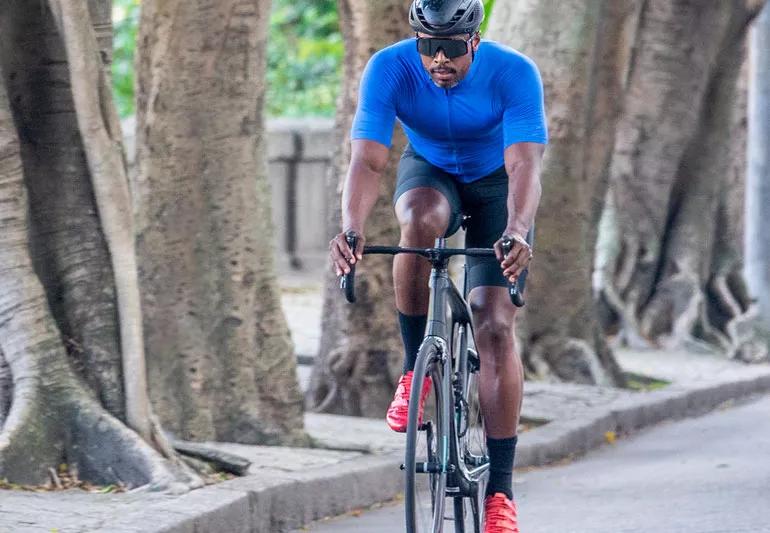Adjust your bike seat, wear breathable clothing and don’t pop or pick!

Whether you’re new to cycling or a seasoned pro, you sometimes pay for that time on the seat. Painful red bumps, sometimes referred to as “saddle sores,” can develop on your thighs and groin area.
Advertisement
Cleveland Clinic is a non-profit academic medical center. Advertising on our site helps support our mission. We do not endorse non-Cleveland Clinic products or services. Policy
While you may think they’re a natural part of being a cyclist, they don’t have to be. There are plenty of preventive ways to help stop saddle sores from happening in the first place, especially when traveling longer distances. But it’s important to make sure the affected area is treated correctly if you do get them.
Sports medicine physician Michael Dakkak, DO, explains why saddle sores happen, how to treat them and how to prevent them in the long run.
If you’re a long-time cyclist, you may have experienced, or at least been warned about, saddle sores. They’re skin irritations that develop in the perineal area, which includes your buttocks, groin and inner thighs.
Saddle sores usually manifest as:
Saddle sores have also been compared to pimples or ingrown hairs, so if you notice something like that in your groin area that isn’t going away — ding, ding — it’s probably a saddle sore.
These sores often result from prolonged pressure and friction caused by riding a bicycle. While a big part of the problem is likely an improperly fitted saddle (bike seat), there are other factors that play into it as well. Mainly, it’s due to the continuous rubbing of your skin against the saddle that can cause inflammation in your groin area.
Advertisement
In other words, the root cause of saddle sores is threefold:
Together, these factors can cause built-up inflammation that leads to irritation, chafing and, you guessed it: saddle sores.
An improper bike fit, excessive cycling mileage and wearing non-breathable clothing can also increase your risk of saddle sores. This is why you don’t have to ride for long periods to get saddle sores either. They can appear even if you’re just starting out with short trips — especially if you don’t have the right bike setup.
“These are different kinds of sores. Sometimes, they are deeper, under the skin like infected hair follicles, clogged pores or deeper abscesses,” Dr. Dakkak says. “But they all have the same root causes — and that’s what guides prevention.”
If you’re noticing some irritation after cycling, here’s how you can treat saddle sores.
Try a gentle warming sensation to help relieve the itchiness of saddle sores. Use a clean, warm compress to help reduce inflammation and quicken the healing process. You can do this a few times a day for about 10 to 15 minutes each time.
Gently wash the affected area with mild soap and warm water to keep it clean and prevent infection. Avoid harsh soaps or scrubbing vigorously — this will only further irritate the sores.
But you don’t want to keep the affected area wet either — moisture can make saddle sores worse. After washing or applying a compress, make sure the area is completely dry before putting on clothing or applying any ointments.
Hands off! No matter how irritated the area can get, picking or popping the sores will only make it worse. It can be tempting, but doing this can lead to infection and further complications. In other words, be patient and let the sores heal naturally over time.
While you’re healing from these cycling wounds, be sure to opt for loose-fitting, breathable clothing made of moisture-wicking fabric. This helps reduce friction and keeps the area dry. Avoid wearing dirty or sweaty clothing, as that can further irritate the area.
It’s also important to keep the area moisturized and your skin barrier protected while healing from saddle sores. Try applying a thin layer of petroleum jelly or an anti-chafing cream to the affected area. This can reduce friction and provide a protective barrier between your skin and whatever it comes into contact with. Doing this can also help prevent saddle sores when you get back into riding (more on that in a moment).
First things first: You may want to hop off your bike for a little while. At the very least, try and avoid any unnecessary, long cycling trips. Give your body time to heal by avoiding cycling until the saddle sores have improved. Continued pressure and friction can worsen your condition and delay the healing process.
Advertisement
Especially if cycling plays a big role in your life — whether as a hobby, fitness routine or a form of transportation — you’ll want to take some precautions to make sure saddle sores don’t slow up your ride.
Here are five ways you can prevent cycling saddle sores and make your bike rides more comfortable.
Finding a well-fitting bike seat is the first step to keeping saddle sores at bay. Bike saddles have different shapes and contours to accommodate how different cyclists ride and sit on their bikes. Your local bike shop can help you determine which seat will work best for you, Dr. Dakkak says.
Managing moisture and germs in the saddle area is very important. This helps keep pores clear and clean and helps avoid infection. You can do this by opting for the right kind of clothing that’s both safe and breathable.
Make sure you wear clean bike shorts each time you ride and remove them immediately after cycling. Wearing well-ventilated, breathable shorts and undergarments after biking allows the area to dry out thoroughly as well.
“There are also special, specific garments made exclusively for cycling which can provide additional padding in regions where sores can commonly occur,” recommends Dr. Dakkak.
Advertisement
Because pressure is also one of the culprits behind saddle sores, make sure you adjust your bike seat to fit the way you ride.
The saddle can move forward, backward and tilt, so take time to figure out what works best for you.
“There is a common misconception that you get saddle sores from not having enough padding on the saddle,” Dr. Dakkak notes. “But more padding isn’t usually the answer. It’s the way you distribute the pressure through the whole body.”
Make sure about a third of your weight is on the saddle, another third is on your hands and the rest of your weight is on your feet, he advises.
Even if you’re a recreational cyclist, investing in the right gear can help reduce saddle sores. Along with making sure you have all the above, you’ll also want the right gear to protect your groin. This means a good pair of bike shorts with a built-in pad — known as a chamois — to keep this sensitive area protected and comfortable.
Dr. Dakkak recommends standing up while riding to take a break from the saddle. If you’re particularly prone to saddle sores, standing up as often as once every two minutes is a good idea.
Over time, you should develop calluses in the saddle area, which is actually a good thing. “It will enable you to ride longer and more comfortably without saddle sores,” Dr. Dakkak explains.
Advertisement
But when you do get saddle sores, it’s best to take a break from your bike to give them time to heal. If you catch them early, they typically go away after a few days off the bike, but deeper sores may take a few weeks, he adds.
While saddle sores can be managed at home in many ways, you should monitor them for any worsening symptoms. If they don’t improve with home care, or show signs of infection such as increased redness, swelling, warmth, pus or development of fever, it’s important to seek medical advice. A healthcare provider can give you a proper diagnosis and recommend the right treatment, such as antibiotic creams or oral antibiotics if necessary.
Learn more about our editorial process.
Advertisement

Stretches, exercises and posture changes can help address lower cross syndrome

Sitting for long hours, like at your desk job, can make your butt sag — among other effects

You may be causing the problem yourself

Physical activity can help preserve and improve your cognitive function and fend off dementia, stroke and other health concerns

Lower-intensity workouts can deliver high-quality health and fitness results

Incremental changes in your exercise routine can improve your strength and endurance over time

Understanding heart rate zones can help you tailor your workout to reach your goals

Increase the size of your muscles by bulking up on protein and focusing on slow, intense movements with progressive overloading

Babies can get congested easily, but you can calm their cough by keeping them hydrated, using nasal drops and running a humidifier

Weight loss may cause loose, sagging skin and muscle loss to your rear

Several conditions, like vitiligo and fungal infection, can cause a loss of pigmentation, leading to white spots or patches on your skin